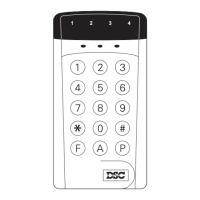12
PROGRAMMING SECTIONS
[01] Zone Definitions
Enter four 2-digit numbers in this section to determine the operating characteristics of each zone.
Zone Definitions: Digit 1
The first digit of each Zone Definition determines each zone’s audible alarm characteristics. When programmed
as
audible,
the siren will sound on alarm; when programmed as
silent,
the siren will not sound on alarm.
Note that zone response times are factory set at 500 ms.
Zone Definitions: Digit 2
Digit 2 determines the zone type as described below:
[0] Standard Delay:
The Standard Delay Zone is normally used for Entry/Exit doors. The Exit Delay starts when
the system is armed; the zone may be opened and closed during the delay without causing an alarm. When
the Exit Delay expires, opening the zone will start the Entry Delay. During the Entry Delay, the keypad buzzer
will sound steadily to indicate that the system should be disarmed. If the system is disarmed before the Entry
Delay expires, no alarm will be generated.
Entry and Exit Delay times may be independently programmed for 1 to 255 seconds in Section [02]. The
default settings are 60 seconds for the Exit Delay, and 15 seconds for the Entry Delay. NOTE: Do not
program the Entry or Exit Delays with [000].
[1] Instant:
Instant Zones are normally used for door and window contacts. Instant Zones have the standard
Exit Delay, but will generate an
instant
alarm when opened after the Exit Delay expires. Refer to Section
[02] for information on programming the Exit Delay; the default setting for the Exit Delay is 60 seconds.
[2] Interior:
Interior Zones are normally used with interior motion detectors and have the standard Exit Delay.
The zone will also have the standard Entry Delay provided that a Delay Zone has been activated before the
Interior Zone. If the premises are entered without coming through a Delay zone and an Interior zone is
tripped, an instant alarm will be generated.
[3] Home-Away with Delay:
Home-Away Zones operate similarly to Interior Zones with the following additional
feature: if the system is armed and a Delay zone is not activated during the Exit Delay time, the Home-Away
with Delay zones will be automatically bypassed. This feature allows the system to be armed with the Home-
Away with Delay Zones automatically bypassed so that the user may remain on the premises.
If a Delay Zone is activated during the Exit Delay, the Entry Delay will be applied to Home-Away with Delay
zones when the Exit Delay expires. If a Home-Away with Delay zone is then activated, the Entry Delay will
be initiated. If a Home-Away with Delay zone is activated during the Entry Delay, that zone will follow the
Entry Delay before generating an alarm if the system is not disarmed.
If the system is armed with the [
∗
][9] At-Home Arming Command, zones programmed as Home-Away with
Delay will remain bypassed until the system is disarmed.
[4] 24-Hour Bell:
24-Hour Bell Zones are active at all times and will sound an alarm even if the system is
disarmed. 24-Hour Bell Zones will activate the bell/siren output if programmed for audible operation.
Alarms on these zones are communicated immediately.
[5] 24-Hour Pulsed Alarm:
24-Hour Pulsed Alarm Zones are active at all times and will sound an alarm even
if the system is disarmed. Alarms on these zones are communicated immediately. NOTE: 24-Hour Pulsed
Alarm Zones should always be programmed as audible so the bell/siren output will be activated when an
alarm is generated. If a silent 24-Hour Zone is required, program the zone as [14].
[02] System Times
Three system times are programmed in Section [02]; each time requires a 3-digit number. Do not press the [#]
Key during data entry.
Entry Delay (001 to 255 seconds) The Entry Delay determines the amount of time permitted between the
activation of a Delay Zone and the disarming of the system. If the system is not disarmed during this delay, an
alarm will be generated. Refer to Section [01] for information on which zone definitions are affected by the Entry
Delay. The default Entry Delay is 15 seconds.
Exit Delay (001 to 255 seconds) The Exit Delay determines the amount of time permitted between entering an
Access Code to arm the system and the activation of a Delay Zone to exit the premises. Refer to Section [01]
for information on which zone definitions are affected by the Exit Delay. The default Exit Delay is 60 seconds.
Bell Cut-Off (001 to 255 minutes) This time determines how long the bell/siren will sound when an alarm is
generated. When an alarm is initiated, the bell/siren will sound for this length of time, or until the alarm is silenced
by entering an Access Code. The default setting is 10 minutes.
[03] Installer’s Code
The default setting for the Installer’s Code is [0560]. It is strongly recommended that the Installer’s Code be
reprogrammed before installation is complete. Be sure to record the new Installer’s Code for later reference.
[04] Programmable Output Options (PGM OUT Terminal)
The PGM output can be programmed to operate in response to various system operations. When activated,
the PGM OUT terminal will switch to ground.
[01] Arm/Disarm Status
The PGM OUT terminal is turned ON (switched to ground) on arming and remains ON as long as the
system is armed. The output is shut OFF when the system is disarmed.
[04] Remote Operation
When programmed for Remote Operation, the PGM OUT terminal can only be turned ON (switched to
ground) or turned OFF on command from the downloading computer. This function may be used to
activate a sounder or other device to indicate that downloading is in progress.
13

